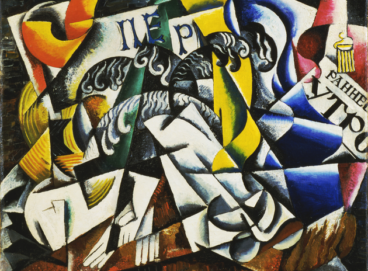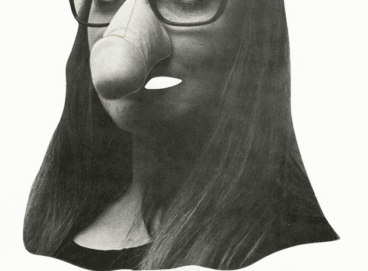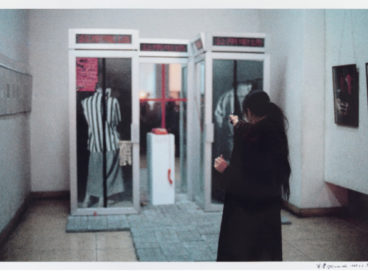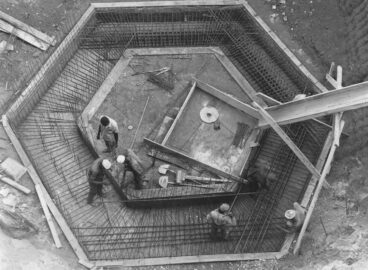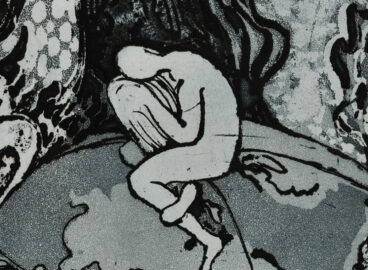Chéri Samba likes to throw people off. The cartoon-like texts with direct messaging that frequently figure in Samba’s complex visual universes function to maintain authorial control. As the artist notes, they are “a way of not allowing freedom of interpretation to the person who looks at my painting.”

Problème d’eau. Où trouver l’eau (Water Problem. Where to Find Water) is a large acrylic painting on canvas by Chéri Samba (Congolese, born 1956). In this self-portrait, made in 2004, the artist has depicted himself in the deep blackness of space, seated just right of center on the nose of a rocket and surrounded by hundreds of carefully arranged stars. As if weightless, his pose evokes Auguste Rodin’s The Thinker, but turned on its side. He has ignored the rules of perspective and instead focused on the details of textures, on the dialogue between his silky, loosely fitting, blood-red suit draped as if on statuary, and a piece of rough rock—the planet Mars, which is poised to meet him. Holding two buckets and a kerosene lamp, which illuminates his face, the artist looks concerned, eminently so, about a complex problem needing to be solved. The bilingual title and English inscription below it float above the scene like a speech bubble in a comic strip, playing the dual role of heading and guide to its subject’s quandary: where to find water.
Originally in the CAAC (Contemporary African Art Collection) of Jean Pigozzi, this painting was notably on display in 2007 in the Italian Pavilion of the 52nd Venice Biennale. There is at least one variation, also from 2004, which is titled only in French: Où trouver l’eau. The composition and colors in this version differ slightly: the corresponding text is not situated at the top of the canvas but rather to the right, above a pebbled planet Mars rendered in moonlike colors. Chéri Samba, though still positioned on the prow of the rocket, has traded in one of his buckets for a small yellow container. In both versions, the subject, coloration, and style evoke Hergé’s On a marché sur la Lune (Explorers on the Moon, 1964), an impression reinforced by the resolutely retro-futurist rocket.
Repetition is not unusual in Chéri Samba’s work. Nor is the staging of the self. Chéri Samba, born (David) Samba wa Mbimba N’zingo Nuni Masi Ndo Mbasi in 1956 in Kinto M’Vuila, in the Bas-Congo (now Kongo Central), is originally from the Democratic Republic of the Congo (DRC), called the Republic of Zaire from 1971 to 1997.
At first glance, it is tempting to read Problème d’eau through the lens of the artist’s origins and to see it as an absurdist social and political critique of the DRC. In the period following the country’s two civil wars (1996–2003), in the contexts of organic corruption and, in particular, the dysfunction of the Congolese Regideso (the public water utility in charge of distribution), to seek water in space may have seemed easier than to resolve local tensions. The slight diagonal of the composition, and its stars, suggest the flag of the DRC: the one in use since 2006, and from 1963 to 1971. The arithmetic of the predominant, repetitive pattern of stars, 6 + 1, suggests another possible layer of meaning, evoking the flag adopted in 1960 during Independence, remobilized in 1997, and in use in 2004, when the artist painted his canvas. Though a tempting reading, it is not a certain one: the diagonal composition may in fact be a formal device, with the stars simply a decorative pattern within it.
Chéri Samba has added a caption below the image: “LIFE IS PRICELESS. CONCERNED FOR HIS PEOPLE SUFFERING FROM DEHYDRATION, CHERI SAMBA GOES LOOKING FOR WATER ON PLANET MARS, AS IF THERE WASN’T ANY WATER LEFT ON EARTH[.] YES . . . IT IS NECESSARY TO SPEND MILLION [sic] OF DOLLARS TO BETTER SERVE HIS PEOPLE IN 100 YEARS.” Yet the artist does not define “his people,” and thus blurs interpretations. The informed observer will note that the list of languages spoken in the DRC is long: French is the official language, while Lingala, Swahili, Ciluba, and Kikongo are national languages spoken by the majority. English, on the other hand, is not on the list. In his paintings, Samba employs all six languages—the choice and order of them, when simultaneous, carefully considered. The text element in Problème d’eau is ambiguous in meaning. Is the artist representing himself as an ambassador for the Congolese people, or in the face of a global impending ecological collapse, as King of the World—thus transforming “his people” into subjects? Since the 1980s, he has repeatedly insisted on the universal scope of his paintings. He has also added that “what we can see in the painting isn’t always of the same nature as, and can even sometimes contradict, what is said and written.” These text elements are “a way of not allowing freedom of interpretation to the person who looks at my painting.”1Bogumil Jewsiewicki, Chéri Samba: The Hybridity of Art / L’hybridité d’un art, Contemporary African Artists Series, no. 1 (Westmont, QC: Galerie Amrad African Art Publications, 1995), 42, 90.

A self-proclaimed “‘undisciplinable’ hero,”2V. Y. Mudimbe, “‘Reprendre’: Enunciations and Strategies in Contemporary African Arts,” in The Idea of Africa (Bloomington: Indiana University Press, 1994), 154–208. Chéri Samba likes to throw people off track. Through his words, he cancels out the visual polysemy of his paintings, while artificially proposing a singular reading. This is a way of blocking subversive interpretations, of protecting himself by pretending not to engage in politics, and of maintaining control over the narrative of his life and work. It is also a way of keeping scholars and curators from attaching their own overly normative (or in any case insufficiently decentered) narratives to his work—or from otherwise bending it to their needs.
The artist’s use of writing can be traced to his plastic practice in Zaire in the 1970s, before he added Chéri to the name Samba. At that time, he was an avid reader of the ephemeral but broadly popular comic strip magazine Jeunes pour jeunes (called Kake starting in 1971), which he copied in order to develop his own drawing style. Upon arriving in Kinshasa in 1972, after a brief stint in the workshops of sign painters from APUZA (Agence publicitaire zaïroise), he found a position as an illustrator-calligrapher for another youth magazine, this one mimeographed in runs of 2,500 copies and widely read in the Congolese capital, entitled Bilenge. Bimestriel humouristique [sic] et d’informations culturelles (Humorous Bimonthly and Cultural Informations). For Bilenge, read: the youth. He illustrated several short strips by Mesa-Tunkadi, and then worked on the images for the longer, more regular strips Lolo m’a déçu (Lolo Let Me Down) and La polygamie et ses conséquences (Polygamy and Its Consequences), which ran between four and six pages, depending on the issue. At the time, he went by the name Dessinateur Samba (Draftsman Samba), or simply Samba. His drawing style, reminiscent of the ligne claire (clear line) pioneered by Hergé, as well as tricks of movement, onomatopoeia, and use of punctuation marks above the characters’ heads, also reveal the influence of Kake, whose graphic genealogy is itself mixed with that of Hergé’s Tintin (fig. 1).
At this time, he was out and about, visiting the studios of the so-called populaires, or folk painters, already established in the capital: Bodo, Chéri Chérin, Moke. As he likes to remind people, the name Samba, thanks to the magazines, was already well-known when, on October 10, 1975, he opened his own studio on the corner of Avenues Kasa-Vubu and Birmanie, in the municipality of Ngiri-Ngiri. The exact date of this opening is not in question: Samba immortalized it in his first self-portrait, Son Éminence-Dessinateur Samba (His Eminence-Draftsman Samba, 1975). In his studio, he painted landscapes, depictions of mami wata (water spirits), and variations on iconic themes in urban painting, all of which were purchased by people in the neighborhood. He showed on the street, using the walls of his studio as an open-air exhibition space. To attract passersby, to arouse their curiosity and create a space for communication, for the “distribution of the sensible,”3Jacques Rancière, The Politics of Aesthetics: The Distribution of the Sensible, ed. and trans. Gabriel Rockhill (London: Bloomsbury, 2013). Samba integrated text into his paintings, which later he would call the griffe sambaïenne (the Samba signature).

In 1978, he participated in the group show Art Partout. Art zaïrois moderne. Peinture populaire (Art Everywhere. Modern Zairian Art. Popular Painting), organized by the Académie des Beaux-Arts of Kinshasa on the occasion of the 4th International Congress of African Studies (ICAS; often incorrectly referred to as the International Congress of African Arts). From then on, he upended scale, entangling the lines of narration—and Samba of Ngiri-Ngiri became Chéri Samba of Kinshasa. He met new people: Jean-Pierre Jacquemin, a Belgian academic working in Kinshasa; Nestor Seeuws, a technical advisor at the Institut des musées nationaux du Zaïre (National Museum Institute of Zaire); Célestin Badibanga ne Mwine, an art critic and department director at the National Museum; and many others. In 1979, his work was included in the imposing exhibition Moderne Kunst aus Afrika (Modern Art from Africa) at the Horizonte ’79 Festival in Berlin. He completed another self-portrait The Draughtsman in 1981, this time depicting himself in a bourgeois living room surrounded by consumer goods, symbols of material comfort and new notoriety: a leather armchair, a record player, a refrigerator, and an illuminated TV set airing the following text: “SUR LE PODIUM / AUJOURD’HUI AVEC / CHERI SAMBA / UNE ÉMISSION DE / HEMEDI M.-MB.” (“ON THE PODIUM / TODAY WITH / CHERI SAMBA / A SHOW BY / HEMEDI M.-MB.”)—a mise-en-abîme of his appearance on the art critic Hemedi Mwanamboyo’s nationally broadcast cultural show in Zaire. Below the image, he subtitled the text in English, French and Lingala, asserting his identity, his polymorphic style, and his status as a self-taught artist: “CARICATURAL DRAWING IS NOTHING, CAUSE ANYBODY EAN DOIT [sic] BUT IT IS RICH CAUSE IT TELLS YOU A MESSAGE ESPECIALLY THERE’ARE TEXTS. I PERSONALLY USE TWO TECHNICS: ‘CARICATURE (HUMOUR) AND PORTRAIT.’ THIS GIVERS A LESSON TO THE ONES WHO ONLY MAKE HUMOUR. YET; I’M A SELF-TAUGHT PERSON” (Fig. 2). In 1989, the exhibition Magiciens de la terre (Magicians of the Earth) introduced him definitively to a global audience.
In the 1980s, he expanded his self-portrait practice—a choice he has explained in several ways. First, he aimed to gain recognition, and second, to protect both his own image and his trade. He has provided details and anecdotes regarding this strategy in interviews: about making himself more recognizable, even though he is not a TV star; about using his own face to avoid having to pay for image rights ever again. But above all, he undertook a conscious practice of self-history, a strategic narcissism to annihilate interpretation and, instead, to propose—indeed, impose—his own personal and collective narrative. The biographical crosses paths with the social, economic, political, and geopolitical themes dear to him.

In his paintings, he comments on himself. He questions and establishes the evolution of his material conditions, his status as an artist, his own fame, the level of that fame, his own place and that of his peers in the art history of his country—and within the larger discipline of art history. In Une peinture à défendre (A Painting to Defend, 1995), he depicts himself protecting a painting by Moke to assert the status of Congolese populaire painting as art. In Le copiste (The Copier, 1990) and its variations, and in Le Contrat. Pourquoi ai-je signé un contrat? (The Contract. Why Did I Sign a Contract?, 1990), he questions the mechanism of the art market and the way it fabricates value and authenticity. Echoing multiple versions of his Hommage aux anciens créateurs (Homage to Ancient Creators, 1995), in which he investigates the place of the classical Africans arts—often gained through colonial pillage—in Western museums, in his triptych Quel avenir pour notre art? (What Future for Our Art?, 1997), he appears alongside Pablo Picasso, presented alternately as peer and then as plunderer, and finally posed within a crowd in front of the tubes of the Centre Pompidou (Musée national d’art moderne, Paris). In this last segment, text alongside the image challenges the place of contemporary African artists in Western museums, begging the question: “LE MUSÉE D’ART MODERNE EST-IL RACISTE?” (IS THE MUSEUM OF MODERN ART RACIST?). His narcissism, while ironic and subtle, is never far from the surface. In Peinture de Chéri Samba (Chéri Samba’s Painting, 1993), he makes fun, in Lingala, of those untrained viewers who cannot understand his work, which he likens to Picasso’s Cubism, also misunderstood in the beginning. In Remerciements à la griffe sambaïenne (Thanks to the Samba Signature, 2000), he congratulates himself for having chosen to mix text and colors at the start of his career.
Within a larger narrative of art history, Samba does not hesitate to settle scores in painting. And so, following publication in 1995 of the book Chéri Samba: The Hybridity of Art,4Jewsiewicki, Chéri Samba. he painted Chéri Samba corrige l’historien Bogumil Jewsiewicki (Chéri Samba Corrects Historian Bogumil Jewsiewicki, 1997). Nonetheless, this did not prevent him that same year, in the spirals of L’espoir fait vivre (Hope Keeps you Going) and L’espoir fait vivre n°2 (Hope Keeps You Going #2), from placing the lectures of Professor Jewsiewikci among the pivotal moments of his life as a man and an artist (fig. 3). In the years that followed, he refined his desire to be part of a larger narrative. In 2002, he made Aussi . . . au plafond (Also . . . on the Ceiling; fig. 4) and Enfin! . . . après tant d’années (Finally! . . . After All These Years), both of which depict a painter with his back to a museum wall. In the former, Chéri Samba sits in front of one of his paintings, which is on display amid works by Frédéric Bruly Bouabré, Cyprien Tokoudagba, Keith Haring, René Magritte, Pablo Picasso, Jean-Michel Basquiat, and Barnett Newman, among others. In the second, he shows the artist Moke standing before his own painting, which is alongside work by Chéri Samba, Barnett Newman, René Magritte (again), and Frédéric Bruly Bouabré (always)—Chéri Samba’s way of proposing a story that, beyond his own personal narrative, should exist.

Coda
The work of Nancy Rose Hunt5Nancy Rose Hunt, “Tintin and the Interruptions of Congolese Comics,” in Images and Empires: Visuality in Colonial and Postcolonial Africa, eds. Paul S. Landau and Deborah D. Kaspin (Berkeley: University of California Press, 2002), 90–123. constitutes a fine and sensitive archeology of the way in which the aesthetics of The Adventures of Tintin by Hergé and of other Belgian comic strips are intimately entangled in the aesthetics and graphic language of comic strips from the Congo—whether developed in support or in opposition to them. Its most immediately palpable example is the reissue of Tintin au Congo (Tintin in the Congo) in the form of an ongoing series in Zairian newspapers in the 1970s. However, Chéri Samba has never expressed his thoughts on the possible compositional kinship between On a marché sur la Lune and Problème d’eau.
Translated from French by Jeanine Herman.
- 1Bogumil Jewsiewicki, Chéri Samba: The Hybridity of Art / L’hybridité d’un art, Contemporary African Artists Series, no. 1 (Westmont, QC: Galerie Amrad African Art Publications, 1995), 42, 90.
- 2V. Y. Mudimbe, “‘Reprendre’: Enunciations and Strategies in Contemporary African Arts,” in The Idea of Africa (Bloomington: Indiana University Press, 1994), 154–208.
- 3Jacques Rancière, The Politics of Aesthetics: The Distribution of the Sensible, ed. and trans. Gabriel Rockhill (London: Bloomsbury, 2013).
- 4Jewsiewicki, Chéri Samba.
- 5Nancy Rose Hunt, “Tintin and the Interruptions of Congolese Comics,” in Images and Empires: Visuality in Colonial and Postcolonial Africa, eds. Paul S. Landau and Deborah D. Kaspin (Berkeley: University of California Press, 2002), 90–123.
